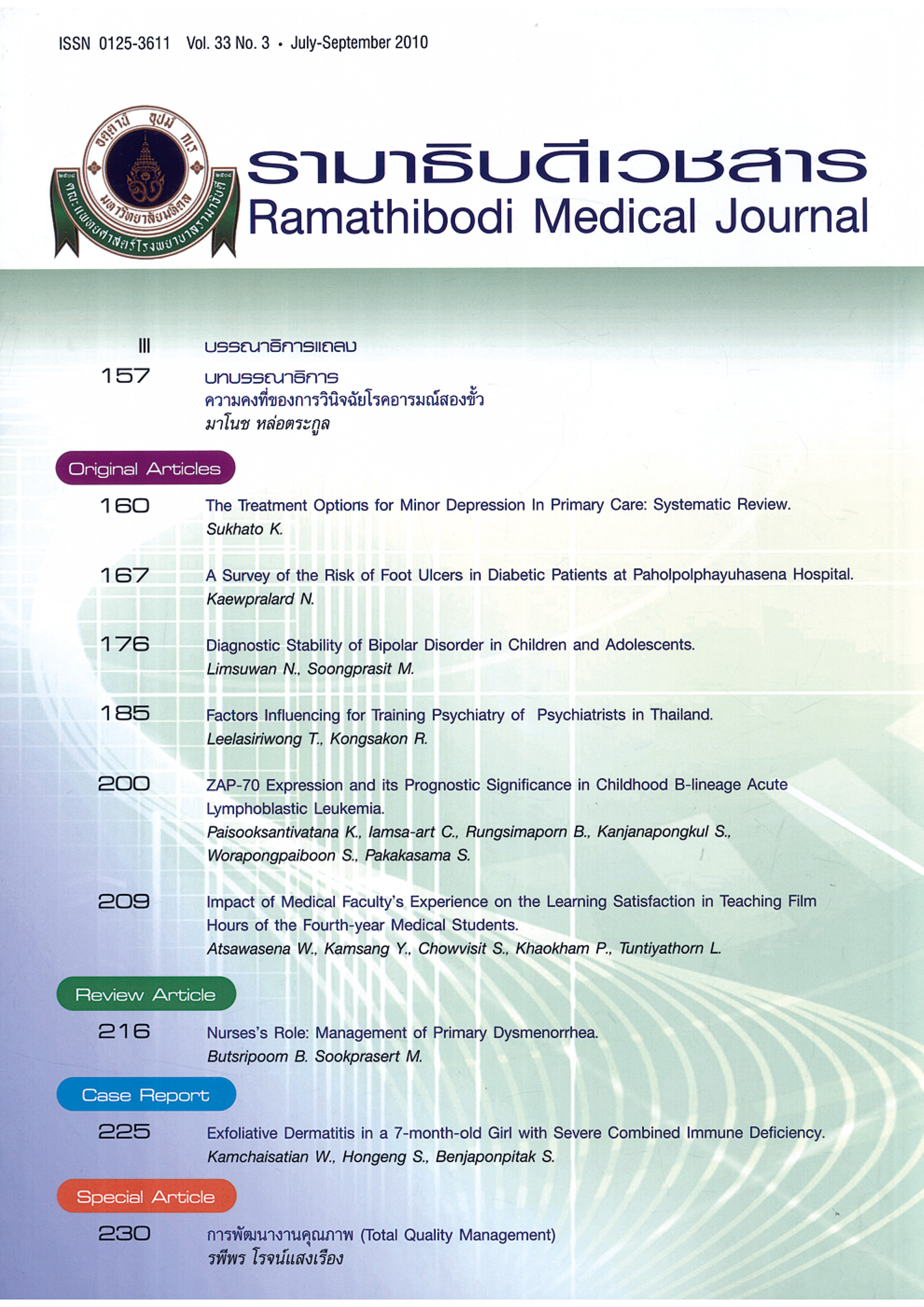The Treatment Options for Minor Depression In Primary Care: Systematic Review
Keywords:
Treatment options, Minor depression, Primary care, SystematicAbstract
Background:Minor depression is more common than major depression in primary care. However, treatment guidelines are usually provided for the major depression. This study purpose is to systematically review the available evidence for treatment of minor depression in primary care.
Method:The databases of PUBMED, CINAHL and Psychlnfo were searched to January 2007. The studies focused on patients suffering from minor depression were included. Two reviewers independently reviewed and extracted data independently.
Results:Total 1038 patients with minor depression from 8 RCTs were identified and analyzed. Sample size of studies varied from 29 to 387 patients and follow up time varied from 6 weeks to 57 months. From the review, the treatment options for minor depression in primary care were grouped into three categories: pharmacologic treatment, psychotherapy and collaborative team care. The effect of pharmacologic treatment (amitriptyline and paroxetine) and psychotherapy (problem-solving therapy and cognitive behavioral therapy) are still controversy when compared with usual care. For the effects of collaborative team care between psychiatrists and primary care physicians, the studies showed no significant outcomes compared with usual care from primary care doctors. However, the long term effect of CBT and behavioral treatment showed the positive effect at 12 months and 57 months respectively.
Conclusion:There are relatively few evidences for treatment minor depression in primary care. The review found three groups of treatment options: pharmacologic treatment, psychotherapy and collaborative team care. However, the effectiveness of these options is still inconclusive. The potential effectiveness from the treatment options of minor depression should be further investigated.
References
Pincus HA, Davis WW, McQueen LE. 'Subthreshold' mental disorders. A review and synthesis of studies on minor depression and other 'brand names'. Br J Psychiatry. 1999;174:288-96. doi:10.1192/bjp.174.4.288.
American Psychiatric Association. Diagnostic and Statistical Manual of Mental Disorder : (DSM-IV). 4th ed. Washington, DC: American Psychiatric Association; 1994.
Olfson M, Broadhead WE, Weissman MM, Leon AC, Farber L, Hoven C, et al. Subthreshold psychiatric symptoms in a primary care group practice. Arch Gen Psychiatry. 1996;53(10):880-6. doi:10.1001/archpsyc.1996.01830100026004.
Hermens ML, van Hout HP, Terluin B, van der Windt DA, Beekman AT, van Dyck R, et al. The prognosis of minor depression in the general population: a systematic review. Gen Hosp Psychiatry. 2004;26(6):453-62. doi:10.1016/j.genhosppsych.2004.08.006.
Wagner HR, Burns BJ, Broadhead WE, Yarnall KS, Sigmon A, Gaynes BN. Minor depression in family practice: functional morbidity, co-morbidity, service utilization and outcomes. Psychol Med. 2000;30(6):1377-90. doi:10.1017/s0033291799002998.
Johnson J, Weissman MM, Klerman GL. Service utilization and social morbidity associated with depressive symptoms in the community. JAMA. 1992;267(11):1478-83.
Oxman TE, Sengupta A. Treatment of minor depression. Am J Geriatr Psychiatry. 2002;10(3):256-64.
Spitzer R, Robin E, Endicott J, NIMH Clinical Research Branch Collaborative Program on the Psychobiology of Depression, New York State Psychiatric Institute. Research Diagnostic Criteria (RDC) for a Selected Group of Functional Disorders. 3rd ed. New York, NY: New York State Psychiatric Institute; 1978.
Ciechanowski P, Wagner E, Schmaling K, Schwartz S, Williams B, Diehr P, et al. Community-integrated home-based depression treatment in older adults: a randomized controlled trial. JAMA. 2004;291(13):1569-77. doi:10.1001/jama.291.13.1569.
Rocca P, Calvarese P, Faggiano F, Marchiaro L, Mathis F, Rivoira E, et al. Citalopram versus sertraline in late-life nonmajor clinically significant depression: a 1-year follow-up clinical trial. J Clin Psychiatry. 2005;66(3):360-69. doi:10.4088/jcp.v66n0313.
Davidson J, Lipper S, Pelton S, Miller RD, Hammett EB, Mahorney S, et al. The response of depressed inpatients to isocarboxazid. J Clin Psychopharmacol. 1988;8(2):100-7.
Mossey JM, Knott KA, Higgins M, Talerico K. Effectiveness of a psychosocial intervention, interpersonal counseling, for subdysthymic depression in medically ill elderly. J Gerontol A Biol Sci Med Sci. 1996;51(4):M172-8. doi:10.1093/gerona/51a.4.m172.
Rapaport MH, Judd LL. Minor depressive disorder and subsyndromal depressive symptoms: functional impairment and response to treatment. J Affect Disord. 1998;48(2-3):227-32. doi:10.1016/s0165-0327(97)00196-1.
Hegel MT, Oxman TE, Hull JG, Swain K, Swick H. Watchful waiting for minor depression in primary care: remission rates and predictors of improvement. Gen Hosp Psychiatry. 2006;28(3):205-12. doi:10.1016/j.genhosppsych.2006.02.008.
Hollyman JA, Freeling P, Paykel ES, Bhat A, Sedgwick P. Double-blind placebo-controlled trial of amitriptyline among depressed patients in general practice. J R Coll Gen Pract. 1988;38(314):393-7.
Miranda J, Muñoz R. Intervention for minor depression in primary care patients. Psychosom Med. 1994;56(2):136-41. doi:10.1097/00006842-199403000-00009.
Katon W, Von Korff M, Lin E, Walker E, Simon GE, Bush T, et al. Collaborative management to achieve treatment guidelines. Impact on depression in primary care. JAMA. 1995;273(13):1026-31.
Katon W, Robinson P, Von Korff M, Lin E, Bush T, Ludman E, et al. A multifaceted intervention to improve treatment of depression in primary care. Arch Gen Psychiatry. 1996;53(10):924-32. doi:10.1001/archpsyc.1996.01830100072009.
Lynch DJ, Tamburrino MB, Nagel R. Telephone counseling for patients with minor depression: preliminary findings in a family practice setting. J Fam Pract. 1997;44(3):293-8.
Williams JW Jr, Barrett J, Oxman T, Frank E, Katon W, Sullivan M, et al. Treatment of dysthymia and minor depression in primary care: A randomized controlled trial in older adults. JAMA. 2000;284(12):1519-26. doi:10.1001/jama.284.12.1519.
Barrett JE, Williams JW Jr, Oxman TE, Frank E, Katon W, Sullivan M, et al. Treatment of dysthymia and minor depression in primary care: a randomized trial in patients aged 18 to 59 years. J Fam Pract. 2001;50(5):405-12.
Wells K, Sherbourne C, Duan N, Unützer J, Miranda J, Schoenbaum M, et al. Quality improvement for depression in primary care: do patients with subthreshold depression benefit in the long run?. Am J Psychiatry. 2005;162(6):1149-57. doi:10.1176/appi.ajp.162.6.1149.
Stephenson J, Imrie J. Why do we need randomised controlled trials to assess behavioural interventions?. BMJ. 1998;316(7131):611-13. doi:10.1136/bmj.316.7131.611.
Sheikh A, Smeeth L, Ashcroft R. Randomised controlled trials in primary care: scope and application. Br J Gen Pract. 2002;52(482):746-51.













